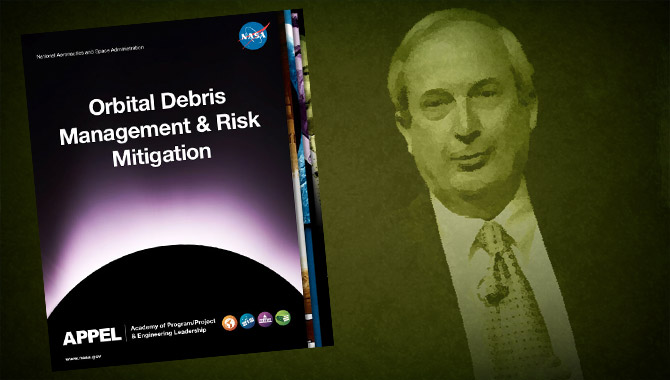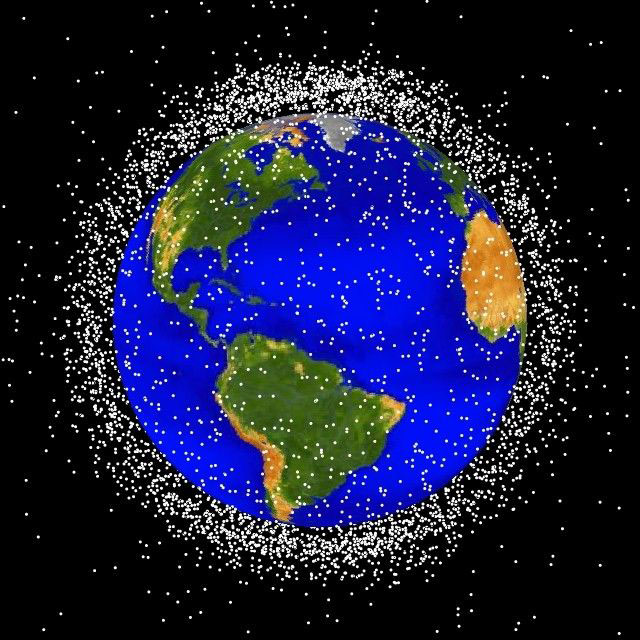
Vol. 5, Issue 10
The future of learning at NASA is no longer confined to a classroom, according to APPEL Director and NASA Chief Knowledge Officer Dr. Ed Hoffman.
On Friday, September 28, 2012, the NASA Academy of Program/Project & Engineering Leadership (APPEL) publicly released its first iBook publication of NASA training materials on the topic of orbital debris management and risk mitigation. This new electronic book platform, introduced in the spring of 2012, enables the seamless integration of text with videos, 3-D models, image galleries, and interactive graphics.
APPEL’s Orbital Debris Management and Risk Mitigation (ODM) training course provides mission-critical knowledge that helps NASA missions meet the agency’s overarching strategic goals and the U.S. National Space Policy goals for sustainability in space. The new iBook supplements APPEL’s existing course taught by Dr. Nicholas L. Johnson, Chief Scientist in the Orbital Debris Program Office at Johnson Space Center. These supplementary materials are now freely available to anyone.
ASK the Academy caught up with APPEL Director and NASA Chief Knowledge Officer, Dr. Ed Hoffman, to gain additional insights about what this new publication suggests about the future of learning at the agency.
ASK the Academy (ATA): The recently released orbital debris iBook repurposed and built upon interactive content and knowledge from APPEL’s existing course on the subject. Why is this exciting?
Ed Hoffman: I’ve been in the learning, training, and education world for thirty years and you’re always limited without realizing you’re limited by the fact that you can only extend your knowledge as far as whoever is in the room. So you typically have twenty, maybe thirty people in the room, and that would be considered a great crowd. That has since changed.
What I’m excited about in terms of the iBook is that now you can have information, lessons, and knowledge materials that are available to anybody in the world at any time. For someone like me, that’s just mind boggling to be able to see that. So you can have the audience in the room, but also engage an audience outside of the classroom.
One of the concerns that I always had in terms of the learning is that we’ve had a lot of great people over the years, over the decades who would present, and it always frustrated me with the fact that I couldn’t capture what these people were delivering so that others outside of the room or outside of the day, the time, and the year could hear it and this opens up a whole different world of opportunity. Orbital debris is a key issue for NASA and the space world. We had the good fortune to get a subject expert, Nicholas [Johnson], who is phenomenal. He’s blessed with both the knowledge and the talent, and he is also a great teacher. So I’m thrilled with the iBook result.
ATA: How do you see this aligning with where APPEL and the agency are headed with leveraging technology to facilitate learning from a distance?
Hoffman: APPEL has always been an advocate for the learning and development of NASA’s engineering and technical workforce. As part of that, we have to deliver knowledge, learning, and training to practitioners to where they are, when they need it.
For me, this type of learning fits with our future in that we’re responding to NASA’s strategic learning priorities in a way that we have to find what are the best ways to establish the learning [content], generate the materials, to use subject matter experts inside and outside of NASA to figure out the best way to be successful with the missions and the challenges we have, and to share it.
Now we have to take it so that we have a platform that can really fly any place. The things that we need to know are not just available in a room, but available anytime. It’s timeless. Some of the things may be important enough so that in 100 years, if people want to click something—if we still click on things then—they’ll be able to hear a presentation from some of the folks that we have in terms of why decisions were made. What were some of the strategies that were used? What have we learned after making this sort of content available?
If you have a smart phone, tablet, or a computer, ideally you should be able to watch aspects of a presentation that are most germane to what someone is interested in, or you could learn a whole series of content. Ideally, to me, that should be the future.
ATA: What other topics might we see covered in this sort of format in the future?
Hoffman:Our goal is to link to what we call NASA strategic learning priorities. A strategic learning priority is something that it is so important to the NASA mission that a large number of people have to hear it, understand it, and learn from it. We need to be on the lookout for those learning priorities.
For something like sustainability, which is a relatively new topic, there’s a lot we need to learn about it. That would be something that I think we could do a lot with and that could go to a really broad community.
APPEL’s International Project Management course addresses what you need to know in terms of managing a complex program that’s international. In the course, 50 percent of the students are from our international partners. The ability to capture aspects of that, or eventually the whole course, so that people all around the world can learn from it, would be the type of targeted training program that I’d like to look at for this type of format.
ATA: What sort of impact do you think this type of learning has on more traditional classroom environments?
Hoffman: I teach courses at George Washington University and Columbia University, and one of the things I’ve found is with distance classes, in many ways, the students in those venues sometimes seem to do a little bit better. And I think it’s because they don’t take for granted the fact that they’re going to be getting together in a room. They know that they sometimes have limited time windows that they can ask questions or talk. They’re working in teams at a distance so they have to be aware of when they come together, how they collaborate. When the technology is really effective it gives an extra charge of we’re connecting, we’re talking, we’re doing things. So I think there are some advantages to distance learning.
Also with distance learning, you have to have a little bit of the artist in you because you can’t rely on the person being there to entertain you, to engage you, to tell you the stories. So you have to look at these new courses from the standpoint of the art, the visuals, the sequencing, the simulations, and the engagement. To me, that’s what I’m so excited about, and that’s why I think it’s so critical because it gives us the chance to try new types of engagement on a worldwide level.
You will still have people who say that none of this stuff can be as good as being in a classroom. There is always going to be a need for the person-to-person, but you can do things in a way that capture the content in a way that is so beautiful that you want to have both.
It also provides the continuity. We’ve had training in the past where people would come together, would establish great relationships, but then there wasn’t connectivity. Now you can have ongoing learning relationships that you could never have in the past.
Download and learn more about the APPEL Orbital Debris iBook.






